Airbus A320-231
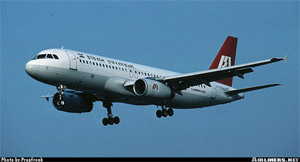
Photo copyright Propfreak - used with permission
Indian Airlines Flight 605, VT-EPN
Bangalore, India
February 14, 1990
On Feb 14th, 1990, Indian Airlines Flight 605, an Airbus A320-231 (Registration VT-EPN), was operating a scheduled passenger flight from Bombay to Bangalore, India. The Captain in the left seat was flying the aircraft and was undergoing the first of 10 route checks required for qualification to Captain. A check airman was flying in the right seat. There were 7 crew members and 139 passengers on board the aircraft. The flight from Bombay to the Bangalore was uneventful. The Weather at Bangalore was good, with landings being conducted on runway 09. The flight crew initially planned for a VOR DME approach to runway 09, but subsequently accepted vectors for a visual straight-in approach.
Initially, the airplane was properly configured for a manual approach and landing, but during the approach, the flight crew made a number of incorrect flight guidance mode selections that led to an extremely low airspeed and low thrust condition in the final stages of the approach. The flight crew did not detect the unusually low airspeed and thrust until a point from which a successful recovery would not be possible. The airplane descended below the planned glide slope and crashed into a golf course, approximately 2800 feet short of the runway, and burst into flames. Four of the seven crewmembers (including both pilots), and 88 of 139 passengers died in the crash.
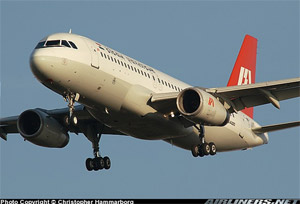
Photo copyright Christopher Hammarborg – used with permission
History of the Flight
On February 14th, 1990, Indian Airlines Flight 605, an Airbus A320-231 (Registration VT-EPN), was operating as a scheduled passenger flight from Bombay, India to Bangalore, India. The pilot in the left seat was flying the aircraft and was undergoing the first of 10 route checks required for qualification to Captain. A check airman was flying in the right seat. There were 5 cabin crew members and 139 passengers on board the aircraft. The flight from Bombay to the Bangalore vicinity was uneventful. Weather on arrival at Bangalore was winds variable at 5 knots, visibility 10 kilometers, with scattered clouds at 2000 feet, and a temperature of 27C. Runway 09 was in use. During the descent into Bangalore, the pilots discussed descent planning, and that they planned to conduct a VOR DME approach (view approach plate) to runway 09, which included altitude constraints of 6000 feet at 11 miles, and 4500 feet at 7 miles. A minimum descent altitude (MDA) of 3280 feet was specified.
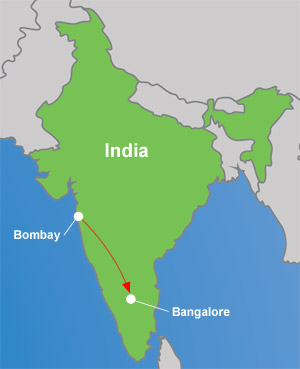
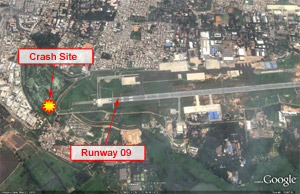
View Larger
During the descent, the flight was cleared by approach control (ATC) for a visual approach, rather than the planned VOR DME approach. A visual approach allows the flight crew to fly the approach without primary reference to flight instruments, and to plan their approach track and flight path visually, in order to arrive at the end of the runway for landing. Flight recorder data indicated to the investigators that just before reaching seven miles from the airport, with the autopilot still connected, the flight crew activated the autopilot approach mode. Activating the approach is unique to Airbus aircraft and is a Flight Management Guidance System (FMGS - autopilot) feature which automatically commands slower aircraft airspeeds, if in the Managed Speed Mode, which is normally the case, during an approach. Commanded/managed speeds will appropriately reduce airspeed to the respective flap maneuvering speed as configuration is changed for landing. Investigators determined from the cockpit voice recorder that the managed approach speed was 132 knots, and this was verified and cross checked by the flight crew. Various airplane configuration changes were subsequently made (flaps and landing gear) while continuing the descent to 4600 feet as cleared by ATC.
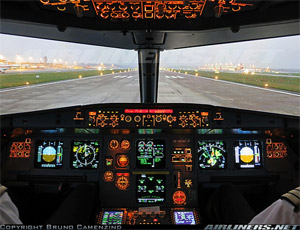
Photo copyright Bruno Camenzind – used with permission
Seven miles from the runway, with the runway in sight, the flight crew disconnected the autopilot and contacted Bangalore Tower.
During the visual approach, with the crew manually flying the airplane, both the left and right flight directors remained engaged, even though the flight directors were not necessary for the visual approach. Use of the flight director during a visual approach was not prohibited in A320 procedures manuals.
Investigators determined that throughout the approach, until the accident, the flight crew made a number of errors in flight control unit and flight director settings that resulted in both engines remaining at idle for an extended period of time, and allowed the airspeed to decay until reaching a point where a thrust increase was automatically commanded by the airplane flight control protection modes. During this period, the airplane slowed from the targeted approach speed of 132 knots down to 106 knots. According to the investigation, as the airplane reached 114 knots, engine thrust was automatically increased toward go-around power. At about the same time, the flight crew, at about 106 knots, recognized the impending impact short of the runway and advanced the throttles to go-around power.
At this point, the time required for the engines to accelerate to go-around power was insufficient to arrest the descent, and the airplane impacted the ground on the Karnataka Golf Course, about 2800 feet before the approach end of the runway. Following this initial impact, the airplane bounced once over a ravine, impacted a second time, and then struck a 12 foot embankment causing both the engines and the landing gear to separate. The airplane came to rest just outside the Bangalore Airport boundary wall, and burst into flames. Four of seven crewmembers (including both pilots) and 88 of the 139 passengers died as a result of the accident.

View Indian Airlines Flight 605 Accident Animation below:
A320 Aircraft – Overview
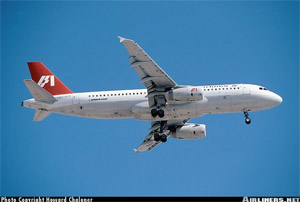
Photo copyright Howard Chaloner – used with permission
The Airbus Industrie A320 is a subsonic, medium range, single aisle, commercial twin engine jet with two high bypass ratio turbofan engines mounted under the wings. The A320 passenger seating layout may vary, up to a maximum of 220 seats. It was the first commercial aircraft to be certified with Fly- By-Wire (FBW) flight controls. Two sidesticks, left and right, are used for manual flight path control. Two non-backdriven thrust control levers on the center aisle stand facilitate engine thrust control through the auto-flight system. The A320 is configured with a combined flight management and auto-flight system which provides flight control guidance to the autopilots and the flight director displays on the Primary Flight Displays and also for engine thrust control. It was also one of the first aircraft to be configured with a "Glass" Flight Deck comprised of six cathode ray tube displays and with an Electronic Centralized Aircraft Monitoring (ECAM) system which facilitates management of aircraft systems and provides alerts and checklist guidance in case of system abnormalities. The A320 is certified to be flown with a two person crew.
Flight Deck and Flight Guidance

The A320 cockpit displays include two Primary Flight Displays (PFD) (outboard left and right), two Navigation Displays (ND) (inboard left and right), and two ECAM displays (mounted vertically in the center of the front instrument panel). The PFD depicts aircraft flight parameters such as attitude, airspeed, and altitude. It also provides flight guidance information with vertical and horizontal bars for lateral and pitch guidance. Across the top of the PFD is the Flight Mode Annunciator (FMA) which is the primary status indicator of auto-flight and auto-thrust modes and engagement status of the auto-pilot, flight directors, and auto-thrust. The ND displays navigational information.
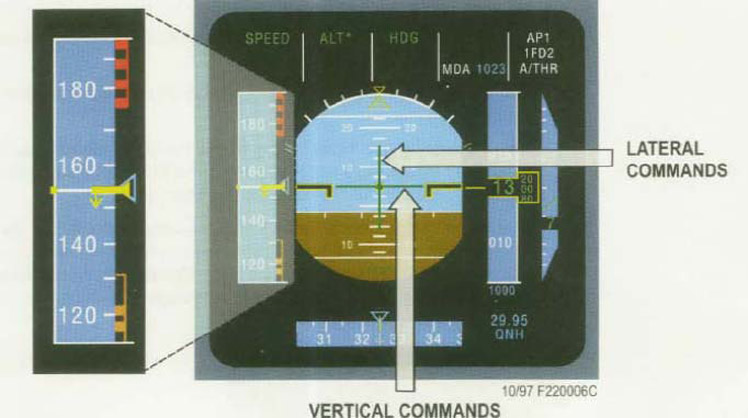
PFD Airspeed Display and Low Speed Protections
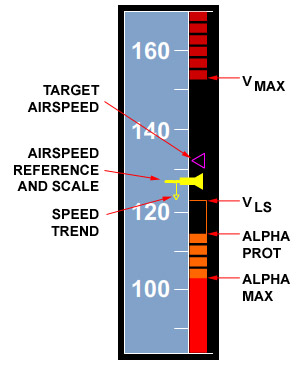
The A320 PFD is laid out in the standard Basic T configuration with attitude in the center, airspeed on the left, altitude on the right, and heading below the attitude display. The airspeed display provides a real time display of actual airspeed, airspeed trend (increasing or decreasing), and airspeed upper and lower limits based on aircraft configuration. Actual airspeed is depicted by a white/yellow airspeed reference line overlaid on the center of a moving airspeed ladder. Also, decelerating or accelerating, a yellow speed trend arrow will display on the reference line. The length of the trend arrow is indicative of the rate of deceleration or acceleration, with the tip of the arrow showing the speed the aircraft will reach in 10 seconds if its deceleration/acceleration remains constant. The target airspeed is presented by a triangle on the airspeed tape – in magenta if "managed" by the Flight Management System (FMS), or in blue if "selected" by the pilot on the Flight Control Unit (FCU). In this accident, the target airspeed was "managed" by the FMS and was set at 132 knots.
When the A320 is in the normal flight control law (as was the case in this accident), the lower end of the airspeed tape will display unique limit speeds; VLS, Alpha Prot, and Alpha Max.
- Minimum Selectable Speed (VLS) - The top of the amber strip along the speed scale indicates VLS. It represents the lowest selectable speed providing an appropriate margin to the stall speed. For the landing approach configuration, VLS is 1.23 times the aircraft stall speed (VS - not shown on the Airspeed Tape).
- Alpha Protection Speed (Alpha Prot) - The top of a black and amber strip along the speed scale indicates Alpha Prot. It represents the speed corresponding to the angle of attack at which alpha protection becomes active. Until reaching Alpha Prot, the A320 pitch control is in a load factor demand (G-command) mode, and operates with apparent neutral speed stability, meaning that there are no changes in longitudinal forces with changes in airspeed (longitudinal stick force changes are basically zero throughout the normal flight envelope). Pitch trim is automatic in the normal airspeed range and there is no requirement for the pilot to make pitch trim changes for airspeed changes. This automatic pitch trim freezes when alpha Prot becomes active. Below Alpha Prot, pitch control reverts to an alpha command mode and aft longitudinal stick forces increase as speed slows and angle of attack (alpha) increases. In this accident, Alpha Prot activated as the airplane decelerated through 114 knots.
- Alpha Max Speed - The top of a red strip along the speed scale indicates Alpha Max Speed. It represents the speed corresponding to the maximum angle of attack that the aircraft can attain in the normal control law of the flight control system, even if the pilot were to pull the sidestick to the aft control stop.
Flight Control Unit

Primary pilot interface with the auto-flight system is via the Flight Control Unit (FCU) mounted centrally on the flight deck glare shield. The FCU contains Auto-pilot (AP1/AP2) and Auto-thrust (A/THR) selection pushbuttons in the center of the FCU. Flight Director (FD) Selector pushbuttons are located outboard of the FCU left and right. Each FD pushbutton only controls display of the FD for its respective side PFD.
The FCU is configured with four knobs which facilitate pilot manual selection of auto-flight speed, roll (lateral), and pitch (vertical) modes. The knobs can be individually pushed to "push" that segment of auto-flight guidance over to being "managed" by the Flight Management System (FMS). Under "Managed" Guidance, the aircraft is guided along a pre-programmed route, vertical, lateral, and speed/Mach profile. FMS flight plan, navigation, performance, and speed/altitude constraint data are pre-programmed or modified via one of the two Multi-Function Display and Control Units (MCDU) located on the center aisle stand forward of the throttle levers.
Any of the four FCU knobs can be pulled to "pull" that segment of auto-flight control to the pilot ("selected" guidance) where the pilot can dial in the desired Speed, Heading/Track, Altitude, or Vertical Speed/Flight Path Angle and override the FMS managed guidance for that segment of auto-flight guidance. During "Selected" Guidance, the aircraft is guided to a "selected" target which is set by the pilot in the FCU. It is possible to fly in a mixed mode configuration, where, for example, lateral guidance of the pre-programmed flight plan route is being "managed" by the FMS but the speed and vertical guidance is “selected" by the pilot.
"Selected" guidance always overrides "managed" guidance. During the Indian Airlines Flight 605 accident sequence, the Speed mode was being "managed" by the FMS and the lateral heading mode (HDG) and the Altitude (ALT) and Vertical Speed (V/S) modes were "selected" by the aircrew. If the autopilot is engaged, standard procedure for many airlines is for the pilot flying the aircraft to make FCU selections. If the pilot flying has disengaged the auto-pilot and is flying manually (as was the case for the Indian Airlines 605 accident sequence), the pilot not flying will make FCU selections/changes when commanded by the pilot flying. Normal operational procedure is to verify that FCU changes are accepted by the auto-flight system by confirming that the PDF FMA annunciation changes are consistent with what was selected on the FCU.
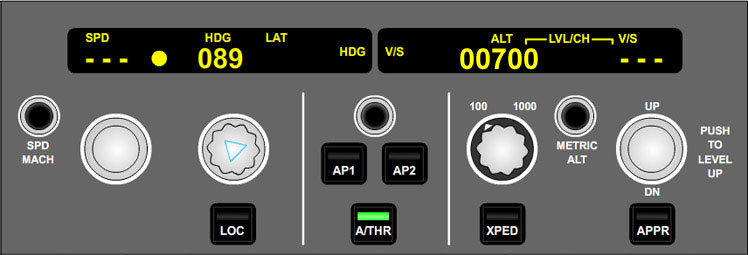
When the FCU Speed (or HDG/LAT) window shows dashes (---), speed (or lateral track) is being "managed" by the FMS. The target speed is shown with a magenta triangle on the PFD airspeed tape. If the pilot "pulls" the speed knob for "selected" guidance, a target airspeed number will be displayed in the FCU speed window and the target speed is shown with a blue triangle on the PFD airspeed tape. Typically, the A320 is flown with speed in the FMS "managed" mode, even on approach where the FMS target speed is the approach speed (Vapp) in the MCDU. During the accident sequence, target speed was being "managed" by the FMS to the target Vapp of 132 knots.
The FCU lateral mode was "selected" (HDG) during the accident sequence since the aircraft was vectored off of the pre-programmed route and was maneuvering visually to line up with the landing runway.
For the A320, the vertical modes can also be "managed" by the FMS where the aircraft will follow a preprogrammed vertical altitude and speed profile. In the "managed" mode, intermediate altitude constraints will be honored as the aircraft climbs or descends toward the FCU target altitude. The aircraft must be in a "managed" lateral mode (flying along a preprogrammed route of flight) in order to be able to be in a "managed" vertical mode. If lateral mode is "selected", then, by system design, the vertical mode must also be in a "selected" mode. The vertical mode can be "managed" or "selected" when the lateral mode is "managed". When the vertical mode is "selected" by the aircrew, the aircraft will climb or descend directly to the FCU target altitude and ignore any intermediate FMS altitude constraints. During the accident sequence, the vertical mode was "selected" such that the descent would continue uninterrupted to the target altitude set in the FCU.
FCU Altitude Changes, Open or Variable Thrust
During both the "managed" and "selected" vertical modes, the Autothrust system can be in a fixed thrust ("Open") mode or in a "Variable" thrust mode. In the "Open" mode, autothrust is set to full climb thrust for an open climb (OPEN CLB) or to idle thrust for an open descent (OPEN DES). Airspeed is controlled by adjusting aircraft pitch, commanded either by the autopilot when it is engaged, or by the flight directors when the pilot is flying manually. The aircraft will stay in the OPEN mode until the FCU target altitude is reached or if the aircrew selects a "variable" thrust climb or descent mode. For a fixed thrust open descent, the FMA display shows engine thrust (IDLE) in FMA Column 1, and the vertical mode (OP DES) in FMA Column 2.

For an OPEN descent to stay active, either the Autopilot, or at least one of the Flight Directors must be selected ON. If the Autopilot and both Flight Directors are OFF, the thrust mode will default to a "variable" thrust mode and engine thrust will be adjusted to maintain target airspeed. If the pilot is manually flying in the OPEN mode, the autoflight system expects the pilot to be following flight director pitch guidance in order to maintain airspeed. If flight director pitch guidance is not followed, large speed deviations will occur.
The normal method of selecting an Open Mode is to select the desired altitude in the FCU window and to "pull"/ "select" the Altitude knob. If the selected altitude is higher than current altitude, Open Climb (OP CLB) will engage and engine thrust will increase to full climb power. If the selected altitude is lower than current altitude, Open Descent (OP DES) will engage and engine thrust will decrease to idle power.
In the variable mode, autothrust will adjust engine power output to maintain the target airspeed, and pitch will be adjusted to maintain a target vertical speed or flight path angle. Variable mode thrust is the appropriate desired thrust mode during final approach. Variable mode will be active whenever a vertical path of some sort is being followed (ILS Glide Path or the Vertical Navigation (VNAV) path of the FMS programmed descent/approach profile), when vertical speed is selected, and/or when there is NO autoflight guidance (auto-pilot and flight directors OFF).
When manually flying a visual approach, A320 aircrews are trained to turn off BOTH Flight Directors to insure that variable thrust is enabled and modulated to maintain target airspeed. If only one Flight Director is turned off, the Flight Director Bars will be removed from that respective side PFD, but thrust will NOT default to variable thrust. The PFD FMA autoflight status will still show one flight director as being engaged.
Autothrust System
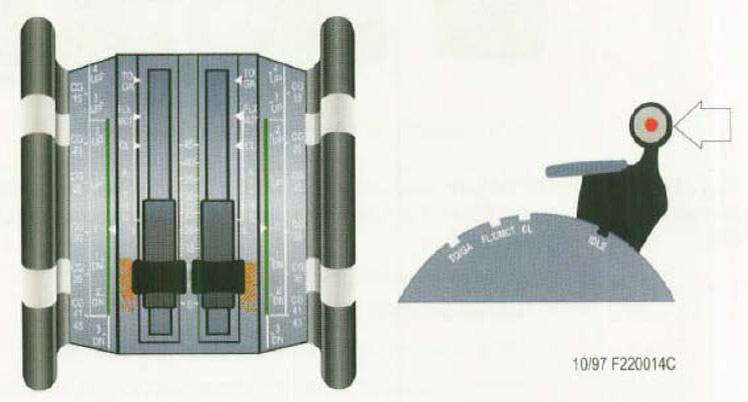
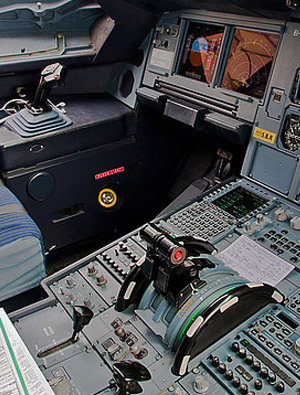
Photo copyright Matteo Stella - Malpensa Spotters – used with permission
View Larger
Thrust control is predominantly accomplished through the autothrust system which is part of the A320 autoflight system. The autothrust system is engaged by arming the autothrust system (THR pushbutton on the FCU panel in flight, or selecting TOGA or FLX for takeoff) and placing the engine thrust levers into the active autothrust range (just above the idle stop up through and including the CL detent when both engines are running; just above the idle stop up through and including the Max Continuous Thrust (MCT) detent for single engine operations). For normal autothrust operation, the thrust levers are placed in the required detent and left there for that phase of flight – TOGA for takeoffs and go-arounds, FLX for reduced thrust takeoffs and for single engine operations, and CL (Climb) for all other two engine phases of flight (climb, cruise, descent, and approach).
The autothrust system is notably different from other transport category aircraft thrust control systems in that the thrust levers are set to a detent, are not normally moved out of the detent, and do not have an autothrust backdrive for the thrust levers. The thrust levers do not move in response to engine thrust changes. The thrust levers remain in the selected detent position until moved by the flight crew. During approach to landing, the autothrust system is disengaged by retarding the thrust levers to the idle stop. The pilot is prompted to do this by a "RETARD, RETARD" aural call out just prior to landing.
Engine thrust is controlled by the autothrust system in response to the autoflight system thrust and vertical flight modes. Engine thrust can either be in OPEN mode (full climb thrust for a climb or idle for an OPEN descent) or a variable speed mode where thrust modulates to maintain target speed. The aircrew controls engine thrust by insuring that the correct autothrust and autoflight modes are selected for the phase of flight being flown. As the aircraft changes from one phase of flight to another (e.g. an open-idle descent to level to capture the target altitude), the autothrust automatically changes from one mode to another (from fixed mode to variable mode for the level off case). While in level flight (variable mode), thrust output varies to maintain the target airspeed. When the autothrust system is active, the thrust levers remain stationary as thrust varies.
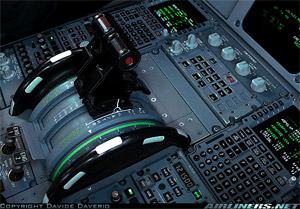
Photo copyright Davide Daverio - used with permission
View Larger
The autothrust system and autothrust commands are based totally upon autoflight flight guidance. Autoflight flight guidance is active if the autopilot or either flight director is ON. When the pilot is flying manually and at least one flight director is ON, and the autothrust OPEN mode is active, the autothrust system expects that the pilot to follow flight director commands. If the PFD flight director command bars are not followed, large speed deviations may occur. Unless a crew member intervenes, the airspeed deviations will increase until additional autoflight and flight control system protections are reached. Therefore it is critical that pilots fly with both FD’s ON or both FD’s OFF.

The status and modes of the autothrust system can be monitored on the PDF FMA Columns 1 (Thrust Mode) and 5 (Autothrust ON, ARMED, or OFF). The FMA autothrust armed status is indicated by A/THR in blue in FMA column 5. Autothrust Active status is indicated by the white A/THR annunciation in FMA column 5. The FMA autothrust OFF status is indicated by the absence of A/THR in FMA column 5.
FMA Column 1 autothrust will display that the autothrust is in a fixed (OPEN) mode, a variable (speed) mode, or in an Autothrust Disconnected mode;
- Fixed Modes – THR CLB, THR IDLE, THR MCT (single engine operations), or THR LVR (Thrust limited due to the thrust lever(s) retarded below the CL detent)
- Variable Modes – MACH or SPEED indicating that autothrust is controlling to a target Mach or speed
- Autothrust Disconnected – Column 1 blank and the FMA column 5 A/THR removed from the display
The thrust levers can also be used for manual pilot control of engine thrust output throughout the full thrust range, but this mode of engine operation is rarely used. The autothrust system can be disconnected by pressing one of the two instinctive disconnect pushbuttons located on the thrust levers. It can also be disconnected by retarding the thrust levers to the idle stop. When autothrust is disconnected using either of these methods, a single aural caution chime occurs, the MASTER CAUTION lights illuminate momentarily, and an A/THR OFF message is briefly displayed on the Engine and Warning Display (E/WD).

When an instinctive autothrust disconnect pushbutton is pressed, autothrust disconnects and the thrust immediately changes to match the thrust lever position. Thrust levers should first be moved to match the current thrust output of the engines (by referencing the small circles above the N1 indications on the engine displays, which represent the actual positioning of the thrust levers in relation to thrust output). Once the autothrust system is disconnected, the pilot manually controls engine thrust output to control speed, much the same as for a conventional aircraft.
High Angle of Attack Protection
Under normal flight control law, when the angle of attack becomes greater than Alpha Prot, the FCS switches elevator control from normal mode to a protection mode in which angle of attack is proportional to sidestick deflection. In the Alpha Prot range (Alpha Prot to Alpha Max), the sidestick commands angle of attack directly. However, the angle of attack will not exceed Alpha Max, even if the pilot gently pulls the sidestick all the way back. If the pilot releases the sidestick, the angle of attack returns to Alpha Prot and stays there. This protection against stall and windshear has priority over all other protections. The autopilot disconnects at Alpha Prot + 1°.
Speeds for Alpha Prot, Alpha Floor, and Alpha Max vary according to the weight and the configuration. To deactivate the angle of attack protection, the pilot must push the sidestick forward more than 8°, or more than 5° if alpha is less than Alpha Max.
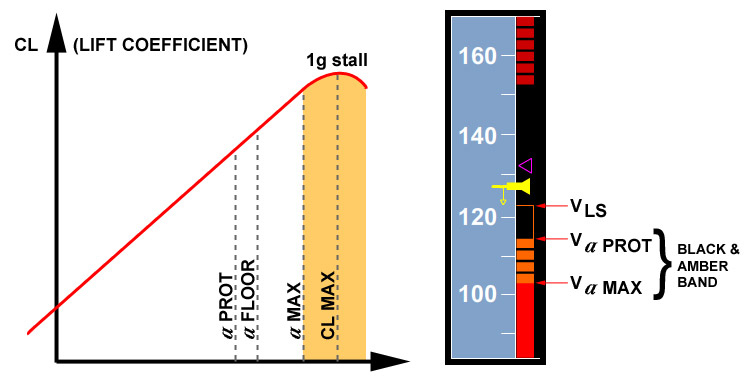

Alpha Floor is an autothrust feature designed to aid the flight crew in recovery from high angle of attack, low airspeed situations. Alpha Floor is available in all flight phases down to 100 feet Radar Altimeter during landing, when the flight control system is in the Normal Flight Control mode.
When Alpha Floor is triggered, the autothrust system automatically increases thrust to TOGA thrust regardless of thrust lever position or autothrust engagement status. "A. FLOOR" displays on PDF FMA Column 1 and on the engine displays. Alpha Floor is a function of angle of attack and therefore, it is not depicted on the PFD airspeed tape.
Accident Sequence
Note: During the accident sequence description, some events are referenced relative to the time stamp on the digital flight data recorder (DFDR), in order to provide proper time perspective for the rapidly occurring events.
During the initial stages of the descent into Bangalore, the autopilot was engaged in "Idle – Open Descent" mode, and the crew discussed their plans to conduct a VOR DME approach. While 42 miles from the airport, ATC identified the airplane on radar, and began issuing maneuvering instructions for a visual approach to runway 09, rather than the crew’s planned VOR DME approach. After passing through 8500 feet, the flight crew activated the approach mode, and verified that the managed approach speed was 132 knots. ATC cleared the flight to 4600 feet, and that altitude was properly set into the FCU as a target level off altitude.
Seven miles west of the airport, and with the runway in sight, the autopilot was disconnected, and the flight crew contacted Bangalore tower. The flight director and autothrust systems remained engaged, and remained in the "Idle – Open Descent" mode, as the airplane was still descending toward 4600 feet. As the airplane passed through 5000 feet, the ALT* mode activated to capture and level off at 4600 feet. The Pilot not flying (PNF) announced the mode change to the pilot flying (PF), as annunciated on the PFD.

In response, the PF then requested "OK, give me go around" to which the PNF asked "Go around you want?" and the PF stated "6000" (meaning the Go-Around Altitude of 6000’ as shown on the approach plate). The PNF did not acknowledge the "6000" but instead asked "Or do you want Vertical Speed" (meaning the Vertical Speed vertical mode). The PF responded, "Vertical Speed". At DFDR time 247, the PNF asked "How Much?", and the PF stated "1000" which was acknowledged by the PNF. Vertical speed mode was then selected and the aircraft entered the Speed/Vertical Speed mode. Investigators believed that sometime during these events, the PNF also likely reset the Altitude Target to 3300 feet, rather than the previously requested 6000 foot go around altitude.

At DFDR time 261, the PF again requested, "Go around, 6,000", but this was not acknowledged by the PNF who was busy getting landing clearance from Bangalore tower. At DFDR time 276, the aircraft was still in the Vertical Speed Mode with a Managed Speed of 132 knots. It descended in vertical speed mode through the visual 3 degree descent path to runway 09 at about 1000 feet AGL (3900 feet MSL).
At DFDR time 292, and about 600 feet above the ground (~3500 feet MSL), the ALT* Vertical Mode again activated. The aircraft was below the visual glide path, with a descent rate of about 1000 feet per minute, in Speed Mode for Thrust, and speed was about 136 knots. Investigators believed that activation of the ALT* Mode was most likely because the PNF had selected the VOR DME MDA altitude of 3300 feet.
At DFDR time 295, the PF then requested, "OK, 700 feet rate of descent" (meaning set the Vertical Speed Mode to 700 feet per minute rate of descent). Instead of acknowledging the "700 feet rate of descent", the PNF commented, "Missed Approach is …..". Also, at this same time, flight recorder data indicated that the Autothrust mode went from "1" to "0" (Open/Idle).
During the 3 seconds between 600 feet and 512 feet above the ground (DFDR 292 to 295), changes occurred in the FMGS Vertical Mode that, upon reaching 512 feet, resulted in the aircraft being in the Idle/Open Descent Vertical Mode with engine thrust reducing to idle. The accident report stated, "the most probable cause for the engagement of idle/open descent mode was that instead of selecting a vertical speed of 700 feet per minute at the relevant time, i.e., about 35 seconds before the first impact, the (PNF) had inadvertently selected an altitude of 700 feet which was well below the runway altitude."
The investigation then concluded "identification of the cause for the engagement of idle/open descent mode on short final approach during the crucial period of the flight is not possible". However, the following probable scenarios were cited by the investigation, and presented in the accident report;
- "the most probable cause for the engagement of idle/open descent mode was that instead of selecting a vertical speed of 700 feet per minute, the PNF had inadvertently selected an altitude of 700 feet (the vertical speed and altitude selection knobs of the Flight Control Unit (FCU) are close to each other). The altitude of 700 feet that got selected in this manner was lower than the aircraft altitude at that time and therefore the aircraft had gone into idle/open descent mode.
- The PNF dialed the wrong (Altitude) knob (thinking that he dialed the Vertical Speed knob) resulting in the selection of a lower altitude ...... It was probable that he wanted to select go around altitude but the words just told to him by the PF regarding vertical speed, influenced his action and thus he selected the altitude of 700 feet without realising that he selected the wrong altitude.
- The PNF first selected a higher altitude towards missed approach alt. of 6000 feet and then realizing that this would activate Open Climb, immediately reversed the alt knob to a lower altitude by a wrist flick which caused the aircraft to go to Idle Open descent."



At DFDR Time 302, the Radio Altimeter called out, "four hundred". Actual rate of descent was about 1000 fpm and airspeed was 129 knots (3 knots below Vapp). The aircraft was about 174 feet below the desired approach path, based on an Airbus analysis of the DFDR performed as part of the investigation.
At DFDR Time 306, the PNF commented "You are descending on idle open descent, ha, all this time." Also at this time, a 300 foot radio altitude call out occurred. Actual rate of descent was about 600 fpm and airspeed was 125 knots (7 knots below Vapp). The aircraft was about 193 feet below the desired approach path.
At DFDR Time 307, the FMGC FD mode discrete data parameter shows as "0". Investigation analysis of the accident concluded that the PF turned off his flight director at that time.
- Turning off BOTH flight directors (with Auto-pilot disengaged) will cause the FMGS vertical and lateral modes to be removed from the Primary Flight Display guidance, the FMA vertical and lateral annunciations to blank out, and the auto-thrust mode will go to Speed Mode using the FMGS target speed (Vapp).
- Turning off only one of the Flight Directors will cause the flight director steering commands to be removed from that side display, however, since auto-flight guidance is still active (since one pilot still had an active Flight Director), the auto-thrust mode will remain in the current active mode (Idle Descent for Flight 605).

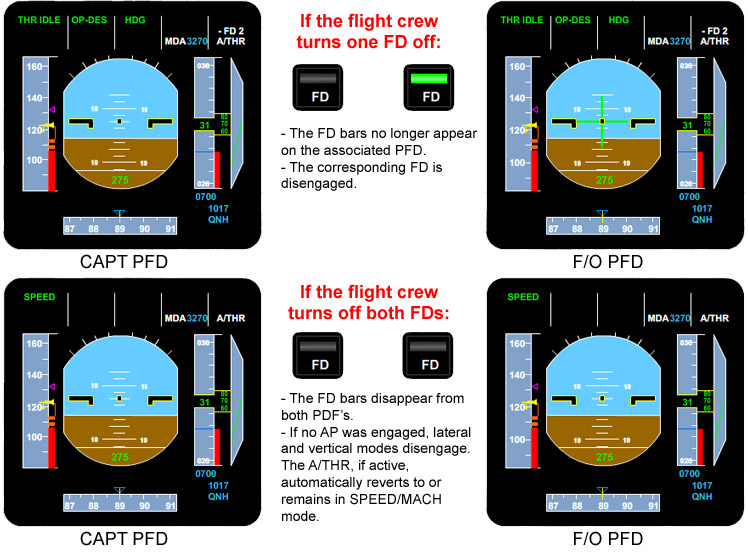
View Larger
In the Board of Inquiry assessment of the Flight Director settings, they state the following regarding the use of Flight Directors;
- "This (FD Mode) discrete does not definitely indicate whether FD1 or FD2 was being displayed on PFD1 or FD1 was switched off. But since bit status was not 1 it is true that there was no dual FD failure. Since the auto-thrust did not change to speed mode, by inference, it is to be concluded that at least one FD remained ON. Since it is known from CVR that (PF) switched off the FD1, therefore it has to be concluded that FD2 remained on. Status of all the above three discretes, therefore, indicate that FD1 word was no more displayed in FMA of PFD1, command bars of PFD1 were removed and FD2 remained ON."
- "This crash would not have happened if ……. both the flight directors had been switched off between DFDR seconds 312 to 317 seconds"
At DFDR Time 309, the PNF asked "You want the flight directors off now?" The PF responds at DFDR Time 310, "Yes. OK, I already put it off." At DFDR Time 313, the PNF comments "But you did not put off mine." There is nothing to indicate that both Flight Directors were ever turned off, even after this comment by the PNF.
The Board of Inquiry provided an analysis of what might have occurred;
- "The (right seat pilot) was the PNF, it was his task to have switched off both FDs. Further, in FCOM chapter 3.02.01 page 3 it has been stated that "procedures will be initiated on (PF) command. PNF – Pilot-non-flying is responsible for execution of required action or request for execution by PF, if applicable." …... In this case (the PNF), instead of putting off both FDs merely asked (the PF)."
- "It appears that even after saying that, (the PNF) still did not put off his own (right side) FD as revealed by the DFDR parameters."
- "Since the auto-thrust did not change to speed mode, by inference, it is to be concluded that at least one FD remained ON. Since it is known from CVR that PF switched off the FD1, therefore it has to be concluded that FD2 remained on."
- "A question may arise in the connection that (the PNF) might have pressed the FD2 button on FCU to switch off his FD. But it did not work for some reason or the other and FD2 continued to remain ON. It can be said against this argument that whenever any person takes any action to achieve something, he always looks for the result of his action. In this case light on FD2 push button and display on FMA and command bars on PFD2 would have given him indication whether FD2 was OFF or not. Further A/thrust mode change from idle to speed in the FMA would also indicate if FD2 was OFF or not. But nothing was commented by (the PNF) at this time about malfunction of the push button as revealed by CVR and the aircraft continued to be in idle open descent."
At DFDR Time 316, a radio altimeter callout of 200 feet occurred. Actual rate of descent was about 600 fpm and airspeed had decelerated to 118 knots (14 knots below Vapp). The aircraft was about 174 feet below the desired approach path, and the engines were still in idle.
At DFDR Time 318, Alpha Prot activated (speed had slowed to the top of the amber barber pole on the speed scale). Actual rate of descent was about 700 fpm and airspeed had decelerated to 114 knots (18 knots below Vapp). Altitude was about 175 feet and the engines were still in idle. From this point on, the PF started to increase aft stick input until it reached the aft stop at DFDR Time 324.


At DFDR Time 320, the PNF asked "You are on the autopilot still?" (Altitude about 160 feet. The reasons for why the PNF made this question are not fully understood.
At DFDR Time 321, the Accident Board of Inquiry assessment is that "During this time-frame plane had moved into the death trap at 321 seconds and no action by the pilots would have saved it."
At DFDR Time 322, the PF responded "No" to the PNF question of "You are on the autopilot still?", to which the PNF responded "It’s Off". About this time Alpha Floor also triggered (engines still at idle, but now being commanded to Go-Around Thrust) and the PF sidestick was almost to the aft stop. Airspeed was 109 knots (23 knots below Vapp). Altitude was about 135 feet.
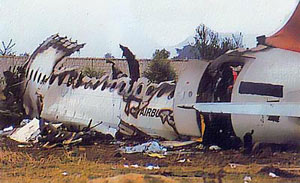
At no time during the period from DFDR Time 295 when Idle Open Descent Mode was entered and the aircraft started to decelerate, until DFDR Time 322 when Alpha Floor commanded Go-Around Thrust, was there any comment by either crew member about airspeed, nor was there any aircrew attempt to change engine thrust setting with the engine thrust levers.
At DFDR Time 323 - The PF sidestick reached the full aft stop. Airspeed was 106 knots, and the rate of descent was about 1300 fpm. The PF stated "Hey, we are going down." The PF advanced the thrust levers to TOGA (Take Off/Go-Around), however, this had no practical effect since the Alpha Floor function had already commanded maximum thrust, and the engines were responding normally. The engines take about 8 seconds to accelerate from idle to Go-Around Thrust. At about the same time, the PNF applied full aft stick input, however, this had no practical effect since the PF had been applying full back stick input ever since the aircraft descended below 100 feet.
At DFDR Time 325, the PF commented, "Captain , Captain still going." Over the next 5 seconds, a Chime sounded, ground proximity warning system alerts of "sink rate" sounded several times, and radio altitude callouts of "fifty" and "ten" occurred. Initial impact occurred at 1303:17 (DFDR Time 330) about 2800 feet before the approach end of runway 09.
The aircraft first impacted a golf course at an airspeed of about 113 knots, with the engines spooling up normally. It bounced, briefly became airborne again, and then impacted a 12 foot embankment about 2200 feet prior to the runway threshold. Both engines were sheared off and the aircraft caught fire. The aircraft came to rest outside the airport boundary wall.
Summary of Key Events in Accident Sequence
Summary table of key events in the accident sequence
DFDR Time |
Altitude AGL |
Speed Mode |
Thrust Mode |
Vertical Mode |
Cause for Mode Change |
|---|---|---|---|---|---|
|
Initial Descent |
To 5000’ MSL (2100’ AGL) |
Managed |
Idle |
Open Descent |
4600’ Alt Capture |
|
Descent to Final |
~5000’ MSL (2100’ AGL) |
Managed |
Variable |
ALT* |
VS Mode Selected |
|
Final Approach Intercept |
To ~3500" MSL (~ 600’ AGL) |
Managed |
Variable |
Vertical Speed |
Alt Capture - most likely because the PNF had selected the VOR DME MDA altitude of 3300’ |
|
292 |
600 AGL |
Managed |
Variable |
ALT* |
FCU ALT or VS Setting Changes |
|
295 |
512 AGL |
Managed |
Idle |
Open Descent |
Alpha Floor |
|
323 |
~ 125’ AGL |
Managed |
Alpha Floor |
THR CLB |
Active Until Impact / TOGA Selected at DFDR Time 324 |
|
325 |
~ 75’ AGL |
Managed |
Alpha Floor / TOGA |
Speed Reference System (SRS) |
Active Until Impact |
|
330 |
Impact |
Managed |
Alpha Floor / TOGA |
SRS |
Impact |
Following the accident, as part of the investigative effort, Airbus Industrie provided a briefing on the key circumstances of the accident. The briefing is available at the following link: (Airbus Briefing)
Canadian Transportation Safety Board Assessment of the Indian Airlines 605 Accident
In the course of the investigation, the Indian government requested support from the Canadian Transport Safety Board (CTSB) in extraction and review of the DFDR information. The CTSB subsequently produced a report, for the Indian government, analyzing the DFDR.
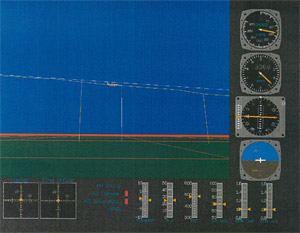
View Larger
The CTSB analysis is a factual report on key aircraft flight parameters and the flight profile - mainly parameters such as airspeed, altitude, heading, and attitude (pitch & roll) as well as flight control and throttle inputs, engine parameters and commands, and control surface positions. Additionally, key avionics system parameters were included as part of the report - Auto-pilot (ON/OFF), Altitude Capture (ALT*) Active (ON/OFF), Auto-Thrust SPEED Mode (ON/OFF), and Ground Proximity Warning System (GPWS) activation (the "Sink Rate" activations at the end of the accident sequence). Added to the report were twelve strip chart data plot graphs showing key data parameters as plotted out by the DFDR reference time.
Through the courtesy and cooperation of the Government of India Director General of Civil Aviation (DGCA), and the CTSB, the CTSB DFDR analysis is provided in the attached link:
Canadian Transportation Safety Board Flight Data Recorder Engineering Report
Additionally, the CTSB DFDR report included a video animation of the accident sequence based on actual second-by-second data parameters from the DFDR. A segment of the animation is available below:
Conclusion
Following this accident, the investigation came to a number of conclusions regarding the chain of events that led to the crash. The investigation placed the majority of responsibility on the flight crew, and actions that should have been accomplished, but were not accomplished during the final 25 seconds leading to the accident. The investigation concluded that:
"The entire crash is the result of what the pilots did not do between 295 to 320 seconds – during 25 seconds (i.e. less than half a minute) and not what they did."
The Accident Report states that "This crash would not have happened if the pilots had taken any one of the following action:
- if the vertical speed of 700 feet as asked for by (Pilot Flying in the Left Seat – PF) at about DFDR 294 seconds had been selected and aircraft had continued in speed/vertical speed mode;
- if both the flight directors had been switched off between DFDR seconds 312 to 317 seconds;
- by taking over manual control of thrust i.e. disconnecting auto thrust system and manually pushing the thrust levers to TOGA (take off - go around) position at or before DFDR 320 seconds (9 seconds to first impact on golf course).
- if the go around altitude of 6000 feet had been selected on the FCU in accordance with the standard procedure at the time it was asked for by (the PF)."
The Court of Inquiry issued 85 findings, all of which were commented upon by the Government of India.
The complete documentation of findings can be viewed at the following link: (Findings)
The Court of Inquiry determined the probable cause to be:
"Failure of the Pilots to realize the gravity of the situation and respond immediately towards proper action of moving the throttles, even after the Radio altitude callouts of "Four Hundred," "Three Hundred" and "Two Hundred" feet, in spite of knowing that the plane was in idle/open descent mode. However, identification of the cause for the engagement of idle/open descent mode on short final approach during the crucial period of the flight is not possible."
A complete copy of the accident report is available at the following link: (Accident Report). (Note: The copy of the accident report used to construct this accident module had a few missing pages and was additionally of poor copy quality. The report was transcribed verbatim in order to enhance the readability, however, certain pages were not available for transcription, and the report, in that sense, is not complete. Efforts to locate and include the missing pages were unsuccessful. Missing pages did not affect the accident board's findings or recommendations.
The accident report states that "The entire crash is the result of what the pilots did not do between 295 to 320 seconds – during 25 seconds (i.e., less than half a minute) and not what they did."
The Government of India approved Accident Report rephrased the probable cause as follows, including some pertinent additions:
"Failure of the pilots to monitor speed during final approach, probably because they diverted their attention to find out the reason for the aircraft going into idle/open descent mode rather than realizing the gravity of the situation and responding immediately towards proper action. This crash would not have happened if the pilots had taken any one of the following action:
(a) if the vertical speed of 700 feet as asked for by Capt. Fernandez at about DFDR 294 seconds had been selected and aircraft had continued in speed/vertical speed mode;
(b) if both the flight directors had been switched off between DFDR seconds 312 to 317 seconds;
(c) by taking over manual control of thrust i.e., disconnecting auto thrust system and manually pushing the thrust levers to TOGA (take off - go around) position at or before DFDR 320 seconds (9 seconds to first impact on golf course).
(d) if the go around altitude of 6000 feet had been selected on the FCU in accordance with the standard procedure at the time it was asked for by Capt. Fernandez."
The accident report contained certain specific findings related to airspeed, autothrust, and use of the Flight Control Unit (FCU), and Flight Director during the accident sequence;
Airspeed Related Accident Findings
Finding # 15. At 13:02:42 (295 DFDR Time Frame - i.e., about 35 seconds before the time of first impact with the ground). the aircraft was at a height of 512 ft. AGL. Since then, it started coming down below the profile and aircraft speed was falling below the target approach speed. There is no specific indication that the crew monitored the speed and height since then.
Gov’t Comment - Agreed.
Finding # 57. Speed drop from 132 kts to 106 kts has taken 26 seconds from DFDR times 297 and 323 seconds.
Gov’t Comment - Agreed.
Finding # 63. CVR has shown no sign of panic or anxiety about speed loss until the PF spoke - "Hey we are going down". There were no calls of speed deviation though speed was 106 kts at DFDR time 323 seconds.
Gov’t Comment - Agreed.
Finding # 64. Low speed display on PFD on A-320 is excellent and they are computer generated. If correct they cannot be mistaken, and speed trend display is compelling. There is no digital read out of value of current speed. PFD Air Speed display data is not recorded on DFDR.
Gov’t Comment - Agreed.
Autothrust Related Findings
Finding # 20. This crash would not have happened:
(c) by taking over manual control of thrust i.e., disconnecting auto thrust system and manually pushing the thrust levers to TOGA (take off - go around) position at or before DFDR 320 seconds (9 second~ to first impact on golf course).
Gov’t Comment - Agreed. This finding could be amplified further by adding that had the pilot set the go round altitude of 6000 feet on the FCU, it would have prevented the aircraft from going into idle open descent mode as it is not possible for the aircraft to go into idle open descent mode below FCU selected altitude.
Finding # 35. Prior to 305 seconds, the aircraft went into idle open descent mode. A conclusive finding as to what pilots did at this point of time is not possible.
Gov’t Comment - Agreed to the extent that "Prior to 305 seconds the aircraft went into idle open descent mode". As regards the cause for engagement of Idle/Open descent mode, the Court itself' at page No. 310, para 14 has noted. "It is also probable that he wanted to select go around altitude first and therefore selected the altitude knob, but while dialing it, the words just delivered to him by CM-l regarding vertical speed influenced his action and thus he selected the altitude of 700 feet without even realizing that he has selected wrong altitude". It was this action of the pilot (PNF) which most probably put the aircraft in idle open descent mode.
Finding # 36. DFDR recording shows that auto thrust speed select discrete changed status from '1' to '0' at 295 seconds. There is no doubt that plane was in idle open descent mode by 305 seconds, by which time the plane was at an altitude lower than 400 feet Radio altitude.
Gov’t Comment - Agreed.
Finding # 37. The aircraft could not sustain the height and speed in the approach profile because of fixed idle thrust in idle open descent mode.
Gov’t Comment - Agreed.
Finding # 38. The aircraft never went to speed mode thereafter, though it was the most proper mode for landing.
Gov’t Comment - Agreed.
Finding # 61. Idle/open descent mode of auto thrust system has engaged some time after DFDR time 295 seconds. The exact reason for this mode engagement cannot be explained or proved because of non-availability of FCU selected altitude data or FCU controls selection data on DFDR.
Gov’t Comment - Acceptable to the extent that FCU selected altitude, or FCU control selection data are not recorded on DFDR. As regards engagement of idle open descent mode, the most probable cause has been explained in comments on finding No. 35.
Finding # 65. Power awareness may be deficient in A-320 pilots when auto thrust is active, as even an Airbus Industrie test pilot was not aware of power required during final approach at 1000 FPM rate of descent.
Gov’t Comment - In regard to this finding, it must be pointed out that in aircraft of this class, auto thrust system is meant to reduce the workload of the pilot on the final approach by maintaining the required speed. It is the speed which is of paramount importance and when flying with manual thrust on this aircraft, it is easy to maintain speed even without referring to engine power indications. This is because of the facility of the speed trend arrow.
Finding # 66. There is no warning if auto thrust brings thrust to idle for whatever reasons during approach.
Gov’t Comment - Agreed.
Finding # 67. Idle/open descent on short final though corresponding to an aircraft in dangerous configuration leading to limit flight condition, is indicated in 'GREEN' on PFD and not in 'RED'.
Gov’t Comment - The finding relates to design features of the aircraft and will be referred to Airbus Industrie.
Finding # 69. Static thrust levers when auto thrust is active removed the feel of thrust lever movement and visual indication of position corresponding to actual thrust or thrust change trend. Only way to know the thrust is to read the value on ECAM.
Gov’t Comment - The finding relates to design features of the aircraft and will be referred to Airbus Industrie. An A-320 operators conference held in Cairo early this year to review the auto thrust fixed throttle concept supported the concept of nonmoving throttles incorporated in A-320 aircraft.
Flight Control Unit (FCU) Related Findings
Finding # 20. This crash would not have happened: (a) if the vertical speed of 700 ft. as asked for by Capt. Fernandez at about DFDR 294 seconds had been selected and aircraft had continued in speed/vertical speed mode;
Gov't Comment - Agreed. This finding could be amplified further by adding that had the pilot set the go round altitude of 6000 feet on the FCU, it would have prevented the aircraft from going into idle open descent mode as it is not possible for the aircraft to go into idle open descent mode below FCU selected altitude.
Finding # 34. CVR-DFDR correlation reveals that at about 38 to 40 seconds prior to the first touch down the aircraft was in proper auto thrust speed mode and was descending in vertical speed mode. At DFDR seconds 292 altitude capture mode was activated indicating that a selection on the FCU panel close to MDA of 3300 ft. had been made at an earlier stage of the flight.
Gov't Comment - Agreed.
Finding # 35. Prior to 305 seconds, the aircraft went into idle open descent mode. A conclusive finding as to what pilots did at this point of time is not possible.
Gov't Comment - Agreed to the extent that "Prior to 305 seconds the aircraft went into idle open descent mode". As regards the cause for engagement of Idle/Open descent mode, the Court itself' at page No. 310, para 14 has noted. "It is also probable that he wanted to select go around altitude first and therefore selected the altitude knob, but while dialing it, the words just delivered to him by CM-l regarding vertical speed influenced his action and thus he selected the altitude of 700 feet without even realizing that he has selected wrong altitude". It was this action of the pilot (CM~2) which most probably put the aircraft in idle open descent mode.
Finding # 61. Idle/open descent mode of auto thrust system has engaged some time after DFDR time 295 seconds. The exact reason for this mode engagement cannot be explained or proved because of non-availability of FCU selected altitude data or FCU controls selection data on DFDR.
Gov't Comment - Acceptable to the extent that FCU selected altitude, or FCU control selection data are not recorded on DFDR. As regards engagement of idle open descent mode, the most probable cause has been explained in comments on finding No. 35.
Flight Director (FD) Related Findings
Finding # 20. This crash would not have happened: (b) if both the flight directors had been switched off between DFDR seconds 312 to 317 seconds; or
Gov't Comment - Agreed. This finding could be amplified further by adding that had the pilot set the go round altitude of 6000 feet on the FCU, it would have prevented the aircraft from going into idle open descent mode as it is not possible for the aircraft to go into idle open descent mode below FCU selected altitude.
Finding # 21. In all probability one of the pilots acted to put off FD.2 by about TF.313 seconds, but FD.2 failed to go off resulting in confusion in the mind of Capt. Gopujkar.
Gov't Comment - Agreed.
Finding # 60. The times of change of FMGC used FD mode and GFC 1 bus (18) discrete status do not correspond to the time of CVR conversation of FDs to be put off and putting them off.
Gov't Comment - The finding is not based on material evidence; hence not acceptable.
Finding # 70. Use of VOR/DME during visual approach is in conformity with Indian Airlines and Aeroformation procedures. Use of FD during visual approach is not prohibited by Airbus Industrie. The pilots in the instant case, followed a visual or a mixture of VOR/DME with visual procedure in all probability.
Gov't Comment - Agreed.
The Court of Inquiry issued 62 recommendations, which were all commented upon by the Indian government. The recommendations can be viewed at the following link: (Recommendations)
Certain specific recommendations relative to airspeed, autothrust, and use of the flight control unit (FCU) and flight director were made:
Airspeed Related Recommendations
Recommendation # 26. Installation of a conventional airspeed indicator unconnected with any computers with a speed bug which could be manually set at the desired V-app, generating an unmistakable audio warning (again unconnected with any computers) fitted on all aircraft when speed drops more than 5 knots below the bug, which have computer generated display of airspeed to be used as the primary speed display may be considered. A provision should be available to check this warning, during the pilots preflight check. Such warning should be serviceable, for release of the flight. Airbus Industrie and Indian Airlines to evaluate retrofit such a feature in place of their present standby airspeed indicator on the A-320.
Gov’t Comment - Not acceptable as a conventional airspeed indicator with a provision of speed bug setting is already available in the aircraft. Too many warnings would only tend to confuse the pilots.
Recommendation # 27. Expanded indication of the value of the current (speed) against the lubber line in the PFD is recommended for better appreciation of current speed value.
Gov’t Comment - Acceptable. Would be brought to the notice of the Airbus Industrie.
Recommendation # 28. A provision of a low-speed warning even under pitch normal law should be examined by the certification authorities at about 1.14 to 1.15 Vsg for this type of FBW aircraft to prevent a similar accident in future.
Gov’t Comment - Airbus Industrie has already brought out a modification by which the aircraft will automatically go into speed mode whenever the speed reaches Lowest Selectable Speed (VLS). As such, this recommendation is not necessary.
Recommendation # 42. Airbus Industrie should immediately amend A-320 FCOM bulletin No.09/2 of June 1990.
Gov't Comment - The FCOM bulletin has already been amended.
(Bulletin Subject - "Assessment of the Aircraft Energy Level". Addressed control and awareness of aircraft energy level, design features to assist in maintaining aircraft energy level (PFD's, FD's, FMA's, etc.), Protections and Low Energy Warning.)
Autothrust Related Recommendations
Recommendation # 29. Due to possibility of mistaking altitude and vertical speed knobs one for the other, a modification is recommended where vertical speed knob would have a wheel to be operated vertically up and down instead of the present clockwise and anticlockwise direction of movement of the knob.
Gov’t Comment - This will be referred to Airbus Industrie as it requires a design change.
No A320 design change was made in response to recommendation # 29.
Recommendation # 30. A very serious human factors evaluation is necessary using ordinary line pilots regarding the loss of direct physical and visual cues by the type of sidestick controls in use in A-320 when compared to dual control wheels operating in unison of the earlier aircraft to determine the adverse impact it may have under critical conditions of flight like that of VT-EPN. Human factor evaluation of moving auto throttles giving feel of thrust increase or decrease versus the static thrust levers of the A-320 auto thrust system using line pilots is recommended to establish advantages and disadvantages.
Gov't Comment - Airbus Industrie has informed the Court that in a conference of users of A-320 aircraft held in Cairo early this year, there was a unanimous opinion for not adopting moving thrust levers. The recommendation is, therefore, not acceptable.
Recommendation # 31. Option of moving auto throttles is desirable in all future aircraft if static auto thrust system similar to A- 320 is to be installed in such aircraft.
Gov't Comment - Airbus Industrie has informed the Court that in a conference of users of A-320 aircraft held in Cairo early this year, there was a unanimous opinion for not adopting moving thrust levers. The recommendation is, therefore, not acceptable.
Recommendation # 32. After gear down and below 2000 feet radio altitude it is recommended that idle/open descent mode should be indicated in flashing red on the FMA associated with a single stroke chime.
Gov't Comment - Partly acceptable and Airbus Industrie will be requested to have a different color for idle/open descent mode display on FMA during final approach.
Recommendation # 33. Airbus Industrie should evaluate the provision of a feature, by which low thrust level occurring, during final approach, even on speed mode due to gusty wind conditions, would attract immediate attention of the pilots; if it occurs every close to the ground it could lead to unsafe situations.
Gov't Comment - Not acceptable technically, as while on approach a pilot has to monitor speed and too many warnings at the critical phase of landing would only cause confusion.
Recommendation # 34. It is recommended that the low range scale of the EPR gauge up to 1.10 should be expanded to give a better indication by the needle of a low thrust condition.
Gov't Comment - Not acceptable as considered not necessary.
Recommendation # 35. Airbus Industrie may look into providing a range in red color up to 1.02 EPR to attract pilots' attention of a low thrust situation when on final approach.
Gov't Comment - Not acceptable as considered not necessary.
Recommendation # 36. Similar features as above could be evaluated and provided for operation in N1 mode.
Gov't Comment - Not acceptable as considered not necessary.
Recommendation # 53. It is recommended that all pilots in India operating automated aircraft be advised that in case of any malfunction of any auto pilot or auto thrust systems or any engagement of undesired mode occurs at altitudes below 1000 feet above ground level manual control should immediately be taken over and if considered necessary a go around should be carried out. No critical investigation or correction on the automated system should be carried out at critical altitudes. Prohibiting the idle/open descent mode below 1000 feet radio altitude should be seriously considered.
Gov't Comment - Acceptable. A circular will be issued to all pilots.
Recommendation # 54. Indian Airlines should very carefully evaluate with the DGCA and Airbus Industrie the advantages of introducing manual thrust operation when manual flight is being carried out on the A-320.
Gov't Comment - Not acceptable as auto-thrust provides greater safety level.
Recommendation # 55. Indian Airlines should carefully evaluate with Airbus Industrie the auto thrust behavior during gusty wind conditions when speed suddenly increases beyond V-app and decreases at altitudes below 200 feet AGL and adverse implications if any to determine the limits of use of auto thrust system. This may have to be evaluated in both cases of Magenta speed or selected speed.
Gov't Comment - Not acceptable as considered not necessary.
Flight Control Unit (FCU) Related Recommendations
Recommendation # 29. Due to possibility of mistaking altitude and vertical speed knobs one for the other, a modification is recommended where vertical speed knob would have a wheel to be operated vertically up and down instead of the present clockwise and anticlockwise direction of movement of the knob.
Gov't Comment - This will be referred to Airbus Industrie as it requires a design change.
Recommendation # 40. A modification to prevent auto thrust mode change from speed mode to thrust mode during Alt* just by change of altitude selection is highly desirable. The mode change should occur only by pulling the altitude knob after change of altitude selection.
Gov't Comment - Already being incorporated.
Recommendation # 60. DFDR should record the selections made by the pilots in the FCU; at present it is not possible to infer many of the actions taken by the pilots during the last phases of the flight. Practicability of getting DFDR recordings of instrument displays such as speed display also should be considered.
Gov't Comment - Acceptable.
Flight Director (FD) Related Recommendations
Recommendation # 39. Installation of a single master switch conveniently located to switch off both FDs when required is recommended; slave switches could be used to switch them 'on' individually or repositioning of both switches centrally be considered.
Gov't Comment - Acceptable. It will be referred to the manufacturer as it requires a design change.
Recommendation # 41. Airbus Industrie should clearly define in their procedures and flight patterns the position at which they need the flight directors to be put off.
Gov't Comment - Use of flight directors are emphasized during training of pilots and a circular would be issued by the Indian Airlines.
A320 Special Conditions for Certification
Since the A320 presented a considerable number of new and novel technologies when it was first introduced, some of these technologies were not addressed within existing regulations. A number of Special Conditions were therefore applied where current regulations did not contain adequate or appropriate safety standards due to novel or unusual design features. The Airworthiness Authorities of Germany, England, and the Netherlands participated with France in a joint certification of the A320 in February 1988. U.S. type certification of the A320 came later in December 1988.
For the A320, Special Conditions were identified for Electronic (Fly-By-Wire) Flight Controls, Active Controls (for Load Alleviation), Engine Controls and Monitoring (for Full Authority Digital Engine Control (FADEC) and for non-moving thrust levers), Protection from Lightning and Unwanted Effects of Radio Frequency (RF) Energy, and for Flight Characteristics, Flight Envelope Protection, Side Stick Controllers, and Flight Data Recorder. As an example, the FAA Special Condition relevant to the Indian Airlines Flight 605 A320 accident was with regards to the non-movable throttle levers in the Engine Controls and Monitoring Special Condition.
Decisions made by the FAA in validation of the A320 type design were similar or identical to the earlier certifying authorities. During the development of this special condition, the subject of non-moving throttles was addressed, and commented on by the public. Similar comments were made by the Indian Court of Inquiry during the flight 605 accident investigation.
- "One commenter recommends that the thrust levers should move corresponding to autothrust commands ....." (to) "provide adequate cues for the flight crew to monitor thrust changes during normal operation * * * ". ....... "The FAA does, not agree, however, that the thrust levers would necessarily have to move during autothrust operation, provided the same (or greater) degree of information feedback regarding thrust commands is being provided to the crew. It is the intent of this special condition to require a satisfactory degree of monitoring capability to be incorporated in the design in order to compensate for the lack of thrust lever motion during autothrust operation."
- "One (commenter) recommends that the ATS (Autothrust System) system should provide thrust lever motion at flight phases below 1500 feet above ground level (AGL) because this is where current autothrottle systems are most effective and important in providing tac" feedback to the pilot through movement of the thrust levers. The FAA agrees that takeoff, approach, and landing are especially important flight phases to be considered in assessing the effectiveness of the ATS command cues, as well as the ease and effectiveness of the disconnect. The FAA does not agree, however, that this may only be accomplished by means of physically moving the thrust levers. The special condition has been reworded to make it clearer as to the objectives of monitoring and override capability, and a new paragraph (5) has been added to address takeoff, approach, and landing.
The final wording for the Non-Movable Throttle Lever section of the Engine Controls and Monitoring Special Condition is as follows;
“(b) Engine Thrust Levers During Autothrust System Operation. In lieu of compliance with § 25.1143(c) of the FAR, it must be established by analysis and test that the A320 automatic thrust system:
- Provides adequate cues for the flight crew to monitor thrust changes without the need for exceptional diligence during normal operation and provides capability for the flight crew to recognize a malfunction or inappropriate mode of operation and take corrective action without the need for exceptional skills.
- Provides a means for the flight crew to disengage or otherwise override the automatic thrust system and regain manual control of engine thrust through normal motion of the thrust levers as defined in § 25.779(b) of the FAR.
- Provides visual cues for any disengagements and provides visual and aural alerts during uncommanded disengagements.
- Functions reliably and does not allow the exceedance of any approved engine operating limit during normal system operation.
- Compliance with paragraphs 1 through 3 above shall include consideration of faults within the automatic thrust system which could affect any or all engines during critical flight operations, such as takeoff, approach and landing.”
The entire text of the FAA Special Condition is available at the following link:
The A320 was the first commercial airliner to be equipped with a fly-by-wire control system. The airplane is highly dependent on computerized systems, and flight deck controls are not connected directly to control surfaces, but rather cause the controls to move via electronic commands. As a result of the highly automated design, Airbus employed a number of protection envelopes to prevent exceedances of airplane limits. In the fully functional flight control mode, the airplane is protected from stalling, exceeding maximum speed limits, or pitch and roll limits. If onboard computer failures occur, some of the protection features function in a degraded state or become non-functional. One of the features of the airplane is the thrust control system, which uses non-moving thrust levers.
Normal use of the thrust levers requires that they be placed in a "detent" and remain in the detent until just before landing. This implementation of thrust control (non-moving throttles) was also new for commercial transport airplanes. The thrust levers are capable of being used in a more conventional manner, by leaving the thrust levers out of the detents, and operating them as more conventional throttles for thrust adjustments. Manual use of the thrust levers precludes use of the autothrust system, however. The airplane also makes use of a sidestick for control of pitch and roll, rather than the more common control column and yoke. The sidestick is located outboard of the pilot positions - to the left of the captain, and to the right of the first officer. The sidestick does not normally provide force feedback and is not backdriven. Control inputs made by the pilot flying are not reflected on the other pilot sidestick.
The Indian court of Inquiry attributed the Flight 605 accident to have been largely the result of an incomplete understanding of the autoflight/autothrust system.
- Failure to properly monitor airspeed and flight path during approach
- Use of incorrect autoflight modes during approach
- Improper crew coordination during a critical flight phase
- Unstable final approach
- Protection features incorporated into highly automated aircraft, such as the A320, reduce the risks associated with pilot/crew error.
The Federal Aviation Administration Human Factors Team Report: "The Interfaces Between Flight Crews and Modern Fight Deck Systems", dated June 18, 1996, listed 24 Automation Interface accidents/incidents. Eight occurred before the Indian Airlines Flight 605 accident, and three were directly related. One event involved an A320, one accident (Delta DC-9-31 on 7/31/73) involved aircrew preoccupation with questionable flight director information which resulted in landing short, and one involved a malfunctioning auto throttle system resulting in crossing the runway threshold 50 knots above reference speed.
Automation Interface accidents/incidents
| Date | Location | Airplane Type | Operator | Description |
|---|---|---|---|---|
| 7/31/73 | Boston | DC-9-31 | Delta Air Lines | Airplane landed short during an approach in fog. Flight crew was preoccupied with questionable information presented by the flight director. Fatal crash. |
| 2/28/84 | New York | DC-10-30 | Scandinavian Airlines | Malfunctioning autothrottle system during approach resulted in crossing the runway threshold at 50 knots above reference speed. Runway was wet, touchdown was 4700 feet beyond the threshold of an 8400-foot runway. Airplane overran runway, minor injuries. Complacency and overreliance on automatic systems cited. |
| 7/3/88 | Gatwick | A320 | unknown | Programmed for 3-degree flight path, but inadvertently was in vertical speed mode, almost landed 3 miles short. |
Since the Indian Airlines Flight 605 accident, highly integrated airplanes like the A320 have become more prevalent in the world fleet. A number of gaps in the areas of crew interfaces in highly automated airplanes have become apparent. The industry at large has taken steps to address these issues. New regulatory material has been developed with the intent to minimize crew error when using installed equipment, and advisory material has been widely distributed by a number or entities and organizations to close those perceived gaps.
Flight Manual Changes
Following the accident, Airbus issued a new flight manual limitation that restricted the use of autopilot or flight directors in DES or OPEN DES mode below 500 feet above the ground, or the minimum descent altitude (MDA) on an approach, whichever is higher. Though this limitation was not made mandatory by airworthiness authorities, it has been distributed to all A320 operators.
Regulations
14 CFR 25.1302 Installed Systems and Equipment for Use by the Flight crew
Advisory Circulars
AC 25-11A Electronic Flight Deck Displays
AC 25.1302-1 Installed Systems and Equipment for Use by the Flight crew
AC 25.1329-1B Approval of Flight Guidance Systems
AC 120-71A Standard Operating Procedures for Flight Deck Crewmembers
AC 120-51E Crew Resource Management Training
Safety Initiatives
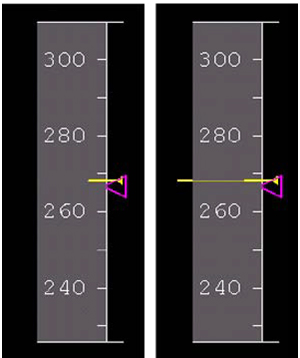
Design Changes
Subsequent A320 system enhancements made in regard to the A320 Airspeed Display and Low Airspeed Awareness include the following;
- The readability of the actual airspeed was enhanced by extending the airspeed reference line across the entire width of the airspeed tape. The airspeed display on the left is how the airspeed reference line was displayed during the Indian Airlines Flight 605 accident.
- "Low energy awareness" is enhanced with an automatic aural warning of "Speed, Speed, Speed" when airspeed decreases below the Low Energy Warning Threshold. Unlike Alpha Floor, the low energy warning is available in degraded flight control law configurations. The low energy warning detection is active when the aircraft is below 2000' and above 100' AGL, flaps are in Config 2 or greater, and Alpha Floor is not engaged. This "SPEED" warning is designed to alert the flight crew so they can preemptively act to avoid triggering Alpha Floor.
Subsequent A320 system enhancements made in regard to the autothrust system include the following;
- Autoflight thrust/vertical modes will change from "Idle - Open Descent" to "Speed - Vertical Speed" if the Speed decreases to VLS. The Autothrust System will then maintain the selected speed and the Flight Director will provide commands to maintain the actual vertical speed at the time of the reversion.
- When the FCU selected altitude is changed while in ALT*, the autoflight system will revert to Speed-V/S instead of reverting to Idle - Open Descent.
- An "IDLE" Indication is displayed on the E/WD engine instrument displays when engine thrust is idle.
- Engine thrust Approach Idle settings for the V2500 engines was increased by 2.5%. This modification was associated with CAT III certification and was not specifically related to the Bangalore event.
If the Indian Airlines accident scenario (with IDLE / OPEN DESCENT; left Flight Director OFF and right Flight Director ON) were to occur in an A320 with the most current Auto-Flight System software, the following would now occur:
- If the FCU selected altitude is changed while in ALT*, the autoflight system will revert to Speed-V/S instead of reverting to Idle - Open Descent.
- If still in IDLE / OPEN DESCENT and speed decreasing, Autoflight thrust/vertical modes will change from "Idle - Open Descent" to "Speed - Vertical Speed" when the Speed decreases to VLS. Also, both flight directors will be removed from display (disabled) and both PDF FMA columns 2 (vertical guidance) and 3 (lateral guidance) will be blank. Thrust will come up to control to the target speed (Vapp).
Low Speed Awareness
Flight Deck Automation / Flight Deck Design / Systems-Avionics Confusion
ICAO CIRCULAR 234-AN/142 - HUMAN FACTORS DIGEST No. 5 - OPERATIONAL IMPLICATIONS OF AUTOMATION IN ADVANCED TECHNOLOGY FLIGHT DECKS - 1992 - Discusses Human Factors implications of automation and advanced technology flight decks.
FAA Human Factors Team Report on The Interfaces Between Flight Crews and Modern Flight Deck Systems - June 18, 1996 - Study evaluating the flight crew/flight deck automation interfaces of current generation transport category airplanes. (Indian Airlines Flight 605 is referenced in the report.)
Airbus Safety Library Publications:
Operations Golden Rules - Discusses proper use of automation and flight guidance
Optimum Use of Automation
Human Factors Aspects in Incidents/Accidents
Flight Safety Foundation Publications:
Flight Safety Foundation (FSF) Approach and Landing Accident Reduction (ALAR) Briefing Note 2.1 – Human Factors – Flight Safety Digest, August – November 2000. - Human Factors involvement in aviation accidents.
Flight Safety Foundation (FSF) Approach and Landing Accident Reduction (ALAR) Briefing Note 1.2 – Automation – Flight Safety Digest, August – November 2000. - Involvement of automation in approach and landing accidents
Crew Resource Management / Incorrect Pilot Technique Accidents
Airbus Safety Library Publications:
CRM Aspects in Incidents/Accidents
Flight Safety Foundation Publications:
Unstabilized Final Approach
Airbus Safety Library Publications:
Aircraft Energy management during Approach
Flight Safety Foundation Publications:
There were no Airworthiness Directives issued as a result of the Indian Airlines Flight 605 accident.
Airplane Life Cycle:
- Design / Manufacturing
- Operational
Accident Threat Categories:
- Crew Resource Management
- Flight Deck Layout / Avionics Confusion
- Incorrect Piloting Technique
Groupings:
- Controlled Flight Into Terrain
- Approach and Landing
- Automation
Accident Common Themes:
- Human Error
Human Error
The Accident Report stated that "the probable cause of the accident may be expressed specifically as follows:- "Failure of the pilots to monitor speed during final approach, probably because they diverted their attention to find out the reason for the aircraft going into idle/open descent mode rather than realizing the gravity of the situation and responding immediately towards proper action of moving the throttles even after the Radio altitude call-outs of "Four Hundred", "Three Hundred", and "Two Hundred" feet, in spite of knowing that the plane was in idle/open descent mode."
- These factors are indicative of human error in monitoring critical aircraft flight parameters and also in interfacing with the aircraft autoflight/autothrottle system. The autoflight system was erroneously placed in an incorrect mode and the crew did not detect the resultant loss of airspeed resulting from the incorrect autoflight mode. Several human errors were made on final approach - setting an incorrect autoflight mode, making autoflight mode changes on final approach, setting a lower altitude on the Flight Control Unit (FCU) (potentially due to selecting the incorrect FCU knob), not turning off Flight Directors, not being on a stabilized approach on final, not monitoring critical flight parameters, and not detecting and correcting a large airspeed deviation from final approach speed.
The Indian Airlines Flight 605 accident involved several key safety issues: Low Speed Awareness, Flight Deck Design and Flight Crew Interface with Aircraft Systems, Crew Resource Management and Piloting Techniques, and an Unstabilized Final Approach. Similar and related accidents are listed below under each safety category. A summary of the related accidents is included below the accident categories and listing of accidents. Some related accidents, similar to Indian Airlines Flight 605, fall into multiple accident categories. Turkish Airlines Flight 1951 falls in all four categories and has the strongest resemblance to many elements of the Indian Airlines Flight 605 accident.
Low Speed Awareness Accidents / Incidents
- Boeing 737-3Q8, G-THOF, Bournemouth Airport, Hampshire, England, September 23, 2007
- Empire Airlines Flight 8284, Aerospatiale Alenia ATR 42-320, N902FX, Lubbock, Texas, January 27, 2009
- Colgan Air, Inc., Continental Connection Flight 3407, Bombardier DHC-8-400, N200WQ, Clarence Center, New York, February 12, 2009
- Turkish Airlines Flight 1951, Boeing 737-800, TC-JGE, Amsterdam Schiphol Airport, February 25, 2009
Flight Deck Design / Systems-Avionics Confusion / Auto-thrust Accidents
- Air Inter Flight ITF 148, Airbus A320-111, Strasbourg, France Date: January 20, 1992
- Air France Flight 072, Boeing 747-428B, F-GITA, Tahiti Faa'a International Airport - Papeete, French Polynesia, September 12, 1993
- China Airlines Flight 140, A300B4-622R, B1816, Nagoya, Japan, April 26, 1994
- TAM Lineas Aereas Flight 3054, Airbus A320, Sao Paulo Congonhas Airport, Brazil, July 17, 2007
- Turkish Airlines Flight 1951, Boeing 737-800, TC-JGE, Amsterdam Schiphol Airport, February 25, 2009
Crew Resource Management / Incorrect Pilot Technique Accidents
- United Airlines Flight 227, Boeing Model 727-22, N7030U, Salt Lake City (SLC), Utah, November 11, 1965
- Empire Airlines Flight 8284, Aerospatiale Alenia ATR 42-320, N902FX, Lubbock, Texas, January 27, 2009
- Colgan Air, Inc., Continental Connection Flight 3407, Bombardier DHC-8-400, N200WQ, Clarence Center, New York, February 12, 2009
- Turkish Airlines Flight 1951, Boeing 737-800, TC-JGE, Amsterdam Schiphol Airport, February 25, 2009
Unstabilized Final Approach Accidents
- United Airlines Flight 227, Boeing Model 727-22, N7030U, Salt Lake City (SLC), Utah, November 11, 1965
- Empire Airlines Flight 8284, Aerospatiale Alenia ATR 42-320, N902FX, Lubbock, Texas, January 27, 2009
- Turkish Airlines Flight 1951, Boeing 737-800, TC-JGE, on Approach to Amsterdam Schiphol Airport, February 25, 2009
Summaries of the Listed Accidents
United Airlines Flight 227, Boeing Model 727-22, N7030U / Salt Lake City (SLC), Utah / November 11, 1965
United Airlines Flight 227, a Boeing 727, crashed during an attempted landing at Salt Lake City Airport. The captain failed to recognize and arrest an excessive sink rate on final approach, resulting in a touchdown 335 feet short of the runway. The main landing gear sheared off, causing a breach in the fuselage, and the airplane caught fire while sliding down and off the right side of the runway.
See accident module
Air Inter Flight ITF 148, Airbus A320-111, Strasbourg, France Date: January 20, 1992
Air Inter Flight 148 was on a scheduled night flight between Lyon and Strasbourg, France. The flight departed Lyon at 1740 local time. The crew originally planned to fly an approach to runway 23 at Strasbourg. However, runway 05 was the active runway and the crew, after being advised that an approach to runway 23 would create delays, accepted the approach to runway 05. At that time, the airplane was very close to the point where the approach would begin. During the initial phases of the approach, while maneuvering to align with the runway, the flight began a very steep descent, after which no further transmissions were heard from the aircraft. The aircraft impacted La Bloss Mountain at an elevation of 2,620 feet, 0.8 nautical miles (nm) left of the final approach course and 10.5 nm from the end of the runway. Eighty-two passengers and five crew members died in the accident.
The Commission of Investigation determined that the cause of the accident was the development of an unusually high descent rate that was not corrected by the crew. The investigation retained two hypotheses regarding the cause of the descent:
- (Quite probable) misunderstanding involving vertical mode (resulting either from an omission to change the trajectory reference, or from poor execution of the command to change it) or of an error in displaying the consigned value (mechanical digital display of the numeric value given out during the briefing).
- (Very improbable) hypothesis of a malfunction of the Flight Control Unit (FCU) (fault in the push-button used for changing mode, or corruption of the consigned value, displayed by the pilot on the FCU before it is captured by the Autopilot computer).
See accident module
China Airlines Flight 140, A300B4-622R, B1816, Nagoya, Japan, April 26, 1994
China Airlines Flight 140 from Taipei, Taiwan to Nagoya - while the copilot was manually flying the ILS approach to runway 34 at Nagoya, and descending through 1,000 feet, he inadvertently activated the go-around switches (also referred to as the GO lever) on the throttles, activating the auto-throttle go-around mode. This resulted in a thrust increase and a climb above the glide path. The first officer attempted to return to the glide path using forward yoke. Subsequent engagement of the autopilot while in go-around mode caused the trimmable horizontal stabilizer (THS) to drive the stabilizer towards its nose up limit as compensation for the manual control inputs via the yoke.
See accident module
TAM Lineas Aereas Flight 3054, A320, Sao Paulo Congonhas Airport, Brazil, July 17, 2007
Just after touch-down, idle reverse was selected on engine 1, followed within 2 seconds by the selection of max reverse. Following reverser 1 selection, the ATHR disconnected as per design and remained disconnected to the end of recording. With the engine 2 throttle being in the Climb position, the engine 2 EPR remained at approximately 1.2 corresponding to the EPR at the time of ATHR disconnection, the ground spoilers did not deploy, and the autobrake was not activated. Maximum manual braking actions began 11 seconds after touch-down. Rudder inputs and differential braking were applied during the landing roll. The aircraft overran the runway at approximately 100 Kts.
The airplane skidded off the runway and flew over a major roadway, striking a gas station and a TAM cargo terminal building where people were working. The airplane immediately burst into flames upon impact with the buildings. There were 187 people onboard with no survivors and numerous people were killed or injured on the ground.
Boeing 737-3Q8, G-THOF, Bournemouth Airport, Hampshire, England, September 23, 2007
The Boeing 737-300 was on approach to Bournemouth Airport following a routine passenger flight from Faro, Portugal. Early in the ILS approach the auto-throttle disengaged with the thrust levers in the idle thrust position. The disengagement was neither commanded nor recognized by the crew and the thrust levers remained at idle throughout the approach. Because the aircraft was fully configured for landing, the air speed decayed rapidly to a value below that appropriate for the approach. The commander took control and initiated a go-around. During the go-around the aircraft pitched up excessively; flight crew attempts to reduce the aircraft's pitch were largely ineffective. The aircraft reached a maximum pitch of 44º nose-up and the indicated airspeed reduced to 82 kt. The flight crew, however, were able to recover control of the aircraft and complete a subsequent approach and landing at Bournemouth without further incident.
The investigation identified the following causal factors:
- The aircraft decelerated during an instrument approach, to an airspeed significantly below the commanded speed, with the engines at idle thrust. Despite the application of full thrust, the aircraft stalled, after which the appropriate recovery actions were not followed.
The investigation identified the following contributory factors:
- The autothrottle warning system on the Boeing 737-300, although working as designed, did not alert the crew to the disengagement of the autothrottle system.
- The flight crew did not recognize the disengagement of the autothrottle system and allowed the airspeed to decrease 20 kt below Vref before recovery was initiated.
Empire Airlines Flight 8284, Aerospatiale Alenia ATR 42-320, N902FX, Lubbock, Texas, January 27, 2009
On January 27, 2009, about 0437 central CST, an Avions de Transport Régional Aerospatiale Alenia ATR 42-320, N902FX, operating as Empire Airlines flight 8284, was on an instrument approach when it crashed short of the runway at Lubbock Preston Smith International Airport, Lubbock, Texas. The captain sustained serious injuries, and the first officer sustained minor injuries. The airplane was substantially damaged.
The National Transportation Safety Board determined that the probable cause of this accident was the flight crew's failure to monitor and maintain a minimum safe airspeed while executing an instrument approach in icing conditions, which resulted in an aerodynamic stall at low altitude. Contributing to the accident were 1) the flight crew's failure to follow published standard operating procedures in response to a flap anomaly, 2) the captain's decision to continue with the unstabilized approach, 3) the flight crew's poor crew resource management, and 4) fatigue due to the time of day in which the accident occurred and a cumulative sleep debt, which likely impaired the captain's performance.
Colgan Air, Inc., Continental Connection Flight 3407, Bombardier DHC-8-400, N200WQ, Clarence Center, New York, February 12, 2009
On February 12, 2009, about 2217 eastern standard time, a Colgan Air, Inc., Bombardier DHC-8-400, N200WQ, operating as Continental Connection flight 3407, was on an instrument approach to Buffalo-Niagara International Airport, Buffalo, New York, when it crashed into a residence in Clarence Center, New York, about 5 nautical miles northeast of the airport. The 2 pilots, 2 flight attendants, and 45 passengers aboard the airplane were killed, one person on the ground was killed, and the airplane was destroyed by impact forces and a postcrash fire.
The National Transportation Safety Board determined that the probable cause of this accident was the captain's inappropriate response to the activation of the stick shaker, which led to an aerodynamic stall from which the airplane did not recover. Contributing to the accident were (1) the flight crew's failure to monitor airspeed in relation to the rising position of the low-speed cue, (2) the flight crew's failure to adhere to sterile cockpit procedures, (3) the captain's failure to effectively manage the flight, and (4) Colgan Air's inadequate procedures for airspeed selection and management during approaches in icing conditions.
Turkish Airlines Flight 1951, Boeing 737-800, TC-JGE, Amsterdam Schiphol Airport, February 25, 2009
Turkish Airlines Flight 1951, a Boeing 737-800, was flying from Istanbul Turkey to Amsterdam Schiphol Airport, on February 25, 2009.
During the accident flight, while executing the approach by means of the instrument landing system with the right autopilot engaged, the left radio altimeter system showed an incorrect height of -8 feet on the left primary flight display. This incorrect value of -8 feet resulted in activation of the 'retard flare' mode of the autothrottle, whereby the thrust of both engines was reduced to a minimal value (approach idle) in preparation for the last phase of the landing. Due to the approach heading and altitude provided to the crew by air traffic control, the localizer signal was intercepted at 5.5 NM from the runway threshold with the result that the glide slope had to be intercepted from above. This obscured the fact that the autothrottle had entered the retard flare mode. In addition, it increased the crew's workload. When the aircraft passed 1000 feet height, the approach was not stabilized so the crew should have initiated a go around. The right autopilot (using data from the right radio altimeter) followed the glide slope signal. As the airspeed continued to drop, the aircraft's pitch attitude kept increasing. The crew failed to recognize the airspeed decay and the pitch increase until the moment the stick shaker was activated. Subsequently the approach to stall recovery procedure was not executed properly, causing the aircraft to stall and crash.
Technical Related Lessons
During approach and landing, one pilot must conduct continuous visual monitoring of airplane airspeed and flight path. (Threat Category: Incorrect Piloting Technique)
- In this accident, a visual approach was being conducted, and the runway was in sight. However, the flight crew elected to fly the approach with the flight director and autothrust system engaged. Confusion over flight director mode changes led to both pilots concentrating on the functioning of the autoflight system, and for the pilot flying to neglect his duties to monitor and maintain airspeed and progress toward the runway (flight path.)
Common Theme Related Lessons
Failures or breakdowns in flight crew communication or discipline can have catastrophic results. The pilot flying must assure execution of requests/commands, and appropriate follow-up must be accomplished. (Common Theme: Human Error)
- Flight 605 was conducting a visual approach to Bangalore. The airplane manufacturer recommended that during a visual approach, both flight directors be turned off. However, during the initial stages of the approach, the flight directors were on, and were providing flight path guidance. As the airplane passed through 5000 feet, the pilot flying (PF) requested that the altitude on the FCU be reset to the go around altitude of 6000 feet. Rather than set 6000 feet as requested, the pilot monitoring (PM) asked if the PF would rather use vertical speed for the next portion of the approach, and never did set 6000 feet on the FCU. Compounding the error, the PF did not verify whether or not 6000 feet had been set. Later in the approach, the investigation believes that the pilot monitoring (PM) also set 3300 feet (the minimum descent altitude for a VOR DME approach) and did not inform the PF of this change. Finally, near the end of the approach, the pilot flying asked for the flight directors to be turned off. This led to a discussion about the PF having already turned his flight director off but had not turned off the pilot monitoring's flight director. Ultimately, the PM did not turn his flight director off, and the pilot flying did not verify that it was off. The Indian Court of Inquiry concluded that if any one of the actions requested by the pilot flying had been carried out, the accident would not have occurred. The failure of the PM to respond to the PF’s requests, and the pilot flying’s failures to verify that his requested actions had been accomplished, led to the accident.
